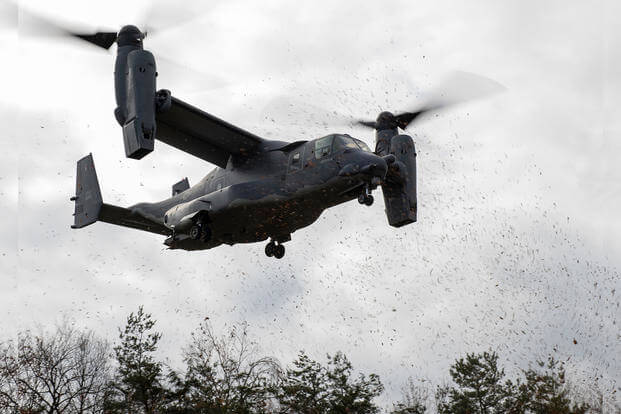
An attorney representing two families who lost loved ones last November in an Air Force CV-22 Osprey crash due to a mechanical failure said a recently released accident report unfairly criticizes the crew, adding to the pain and suffering those families are experiencing.
Timothy Loranger, an aviation attorney and senior partner at Los Angeles’ Wisner Baum law firm, said in a statement Wednesday that, while the report’s findings point to a catastrophic mechanical failure, they also place blame on the crew for not responding properly, a point he and his clients contest.
“The loss of these brave individuals is a profound tragedy, and any suggestion that places blame on those who are no longer here to defend their actions only adds to the deep pain their families are already enduring,” Loranger said in the statement. “These Gold Star families deserve our support and compassion, not devastating insinuations which overlook the literal cause of the tragedy and focus on the question of whether their loved ones could have done more.”
Read Next: Gearbox, Crew Blamed for Deadly Japan Osprey Crash in Results of Air Force Investigation
The Air Force released its investigation into the Nov. 29 crash off the southern coast of Japan on Thursday. The findings, first reported by Military.com, pointed to gearbox components that began chipping and shredding debris that lodged between other components and caused the left proprotor to stop turning and the aircraft to plummet to the ground, killing all eight Air Force special operations airmen aboard.
But Air Force investigators also placed some blame on the crew, saying they “inadequately prioritized continuing the mission over considerations related to the risk of extended flight without redundancy.”
Loranger said the findings highlight larger themes with the V-22, pointing to what he called the cultural issue of downplaying concerns as mechanical issues continue to plague the aircraft.
The attorney also represents families of Marines killed in a 2022 V-22 Osprey training crash in California. They filed a wrongful death lawsuit in May against Bell Textron and Boeing, which design and manufacture the aircraft, and Rolls-Royce, which designs and manufactures the engines.
Loranger told Military.com that the Air Force families he’s representing are “interested in understanding what caused the ultimate failure of this aircraft” and they plan to further investigate the accident.
“We will be looking deeper into it, and then we’ll make a decision later on about whether or not there could be litigation,” he added.
During the fatal Nov. 29 flight, the pilots received alerts warning that there were tiny metal chips in the Osprey gearbox but adding that the onboard systems were addressing them. After a third warning, Air Force policy at that time stated the crew of Gundam 22 — the Osprey’s call sign — should land as soon as practical, but the ultimate decision was up to them. They continued the mission even after receiving two more warnings, but then received a serious notification of a persistent chip in the gearbox telling them to land as soon as possible.
The aircraft crashed prior to reaching a small airport on Yakushima Island in Japan.
Lt. Gen. Michael Conley, the head of Air Force Special Operations Command, told reporters at a briefing Wednesday that the crew did not violate any policy and followed their training.
He added that “this is the first time that this specific part has failed on a V-22 of any type in almost 800,000 flight hours.” Conley also noted that AFSOC protocol has changed since the Nov. 29 crash, and crews are now asked to land as soon as practical after a single chip burn warning and “as soon as possible” after a second warning.
Loranger told Military.com on Friday that it’s hard to criticize the crew, especially given the fact that AFSOC has since changed its procedures regarding warnings of chips in the gearbox.
“There’s a tendency to want to look at the human factor, which you have to do,” Loranger said. “But now we’re going to blame the pilots and say, ‘Well, they should have done something different’ when the procedure that they knew existed, the procedure itself, didn’t resolve the problem. In hindsight, we now know the procedure was bad.”
Related: Deadly Marine Osprey Crash Triggers Wrongful Death Lawsuit Against Bell Textron, Boeing, Rolls-Royce






